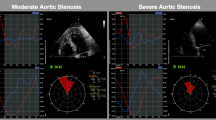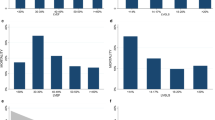Abstract
The impact of left ventricle (LV) hypertrophy (LVH) regression on contractility-associated measures, the extent of residual cardiac dysfunction and prognostic implications after the initial remodeling process after transcatheter aortic valve replacement (TAVR) has not been investigated. We aimed to assess whether greater LV mass regression from pre-TAVR to 12-months after TAVR was associated with increased systolic function; and assess the prognostic value of residual LVH, systolic function and contractility-associated measures 12-months after TAVR. A total of 439 symptomatic patients were included and examined by echocardiography. LVH regression was assessed as percentage change in LV mass index (LVMi) from baseline to 12-months after TAVR. Midwall fractional shortening (mFS) and stress-corrected (SC-mFS) were used as contractility-associated measures. Primary outcome was all-cause mortality. SC-mFS increased from 0.94 (0.7) at baseline (BS) to 1.22 (0.7) (p < 0.05) 12-months after TAVR for patients with the most LVH regression, compared to patients with no LV regression (BS 1.06 (0.7) to 1.04 (0.5), NS). At 12-months after TAVR, multivariate analysis showed independent prognostic value of LVEF < 50% or GLS < 15% (HR 1.59, p = 0.049) and mFS < 14% (HR 1.99, p = 0.002) for future all cause death. LVH regression in AS after TAVR is associated with significant improvements of LV systolic function in contrast to patients without LV regression. Residual LVH and subsequent LV systolic dysfunction is substantial 12 months after TAVR and are associated with reduced survival. Impaired mFS and the combination of abnormal LVEF or GLS independently predicted all-cause mortality beyond 12 months after TAVR.



Similar content being viewed by others
Abbreviations
- AS:
-
Aortic stenosis
- AVR:
-
Aortic valve replacement
- GLS:
-
Global longitudinal strain
- LV:
-
Left ventricle
- LVEF:
-
Left ventricle ejection fraction
- LVH:
-
Left ventricle hypertrophy
- LVM:
-
Left ventricle mass
- LVMi:
-
Left ventricle mass indexed
- mFS:
-
Midwall fractional shortening
- TAVR:
-
Transcatheter aortic valve replacement
References
Grossman W, Jones D, McLaurin LP (1975) Wall stress and patterns of hypertrophy in the human left ventricle. J Clin Invest 56(1):56–64
Gerdts E (2008) Left ventricular structure in different types of chronic pressure overload. Eur Heart J Suppl. 10(suppl_E):E23–E30
Dweck MR, Boon NA, Newby DE (2012) Calcific aortic stenosis: a disease of the valve and the myocardium. J Am Coll Cardiol 60(19):1854–1863
Gaasch WH, Zile MR (2011) Left ventricular structural remodeling in health and disease: with special emphasis on volume, mass, and geometry. J Am Coll Cardiol 58(17):1733–1740
Leon MB, Smith CR, Mack M, Miller DC, Moses JW, Svensson LG et al (2010) Transcatheter aortic-valve implantation for aortic stenosis in patients who cannot undergo surgery. N Engl J Med 363(17):1597–1607
Chau KH, Douglas PS, Pibarot P, Hahn RT, Khalique OK, Jaber WA et al (2020) Regression of left ventricular mass after transcatheter aortic valve replacement: the PARTNER trials and registries. J Am Coll Cardiol 75(19):2446–2458
Ito S, Pislaru C, Miranda WR, Nkomo VT, Connolly HM, Pislaru SV et al (2020) Left ventricular contractility and wall stress in patients with aortic stenosis with preserved or reduced ejection fraction. JACC Cardiovasc Imaging 13(2 Pt 1):357–369
Baumgartner H, Falk V, Bax JJ, De Bonis M, Hamm C, Holm PJ et al (2017) ESC/EACTS Guidelines for the management of valvular heart disease. Eur Heart J 38(36):2739–2791
Kang DH, Park SJ, Lee SA, Lee S, Kim DH, Kim HK et al (2020) Early surgery or conservative care for asymptomatic aortic stenosis. N Engl J Med 382(2):111–119
Banovic M, Putnik S, Penicka M, Doros G, Deja MA, Kockova R et al (2021) Aortic valve replacement versus conservative treatment in asymptomatic severe aortic stenosis: the AVATAR trial. Circulation 144(25):E565–E565
Lang RM, Badano LP, Mor-Avi V, Afilalo J, Armstrong A, Ernande L et al (2015) Recommendations for cardiac chamber quantification by echocardiography in adults: an update from the American Society of Echocardiography and the European Association of Cardiovascular Imaging. J Am Soc Echocardiogr 28(1):1-39.e14
Lindman BR, Stewart WJ, Pibarot P, Hahn RT, Otto CM, Xu K et al (2014) Early regression of severe left ventricular hypertrophy after transcatheter aortic valve replacement is associated with decreased hospitalizations. JACC Cardiovasc Interv 7(6):662–673
Gaudino M, Alessandrini F, Glieca F, Luciani N, Cellini C, Pragliola C et al (2005) Survival after aortic valve replacement for aortic stenosis: does left ventricular mass regression have a clinical correlate? Eur Heart J 26(1):51–57
Gavina C, Falcão-Pires I, Rodrigues J, Marinho B, Gonçalves N, Lopes R et al (2014) Load independent impairment of reverse remodeling after valve replacement in hypertensive aortic stenosis patients. Int J Cardiol 170(3):324–330
Lund O, Emmertsen K, Dørup I, Jensen FT, Flø C (2003) Regression of left ventricular hypertrophy during 10 years after valve replacement for aortic stenosis is related to the preoperative risk profile. Eur Heart J 24(15):1437–1446
Einarsen E, Saeed S, Cramariuc D, Chambers JB, Midtbø H, Gerdts E (2019) Impact of obesity on persistent left ventricular hypertrophy after aortic valve replacement for aortic stenosis. Am J Cardiol 123(6):942–947
Angelillis M, Giannini C, De Carlo M, Adamo M, Nardi M, Colombo A et al (2017) Prognostic significance of change in the left ventricular ejection fraction after transcatheter aortic valve implantation in patients with severe aortic stenosis and left ventricular dysfunction. Am J Cardiol 120(9):1639–1647
Lessick J, Mutlak D, Markiewicz W, Reisner SA (2002) Failure of left ventricular hypertrophy to regress after surgery for aortic valve stenosis. Echocardiography 19(5):359–366
Merillon JP, Neukirch F, Motte G, Aumont MC, Curien ND, Prasquier R et al (1981) The left ventricular end-systolic pressure-volume ratio Studies during changes in load and inotropism in the human. Eur Heart J 2(1):41–48
Poulsen SH, Søgaard P, Nielsen-Kudsk JE, Egeblad H (2007) Recovery of left ventricular systolic longitudinal strain after valve replacement in aortic stenosis and relation to natriuretic peptides. J Am Soc Echocardiogr 20(7):877–884
Povlsen JA, Rasmussen VG, Vase H, Jensen KT, Terkelsen CJ, Christiansen EH et al (2020) Distribution and prognostic value of left ventricular global longitudinal strain in elderly patients with symptomatic severe aortic stenosis undergoing transcatheter aortic valve replacement. BMC Cardiovasc Disord 20(1):506
Attias D, Macron L, Dreyfus J, Monin JL, Brochet E, Lepage L et al (2013) Relationship between longitudinal strain and symptomatic status in aortic stenosis. J Am Soc Echocardiogr 26(8):868–874
Dahl JS, Eleid MF, Michelena HI, Scott CG, Suri RM, Schaff HV et al (2015) Effect of left ventricular ejection fraction on postoperative outcome in patients with severe aortic stenosis undergoing aortic valve replacement. Circ Cardiovasc Imaging 8(4):e002917
Capoulade R, Le Ven F, Clavel MA, Dumesnil JG, Dahou A, Thébault C et al (2016) Echocardiographic predictors of outcomes in adults with aortic stenosis. Heart 102(12):934–942
Ito S, Miranda WR, Nkomo VT, Connolly HM, Pislaru SV, Greason KL et al (2018) Reduced left ventricular ejection fraction in patients with aortic stenosis. J Am Coll Cardiol 71(12):1313–1321
Dahl JS, Magne J, Pellikka PA, Donal E, Marwick TH (2019) Assessment of subclinical left ventricular dysfunction in aortic stenosis. JACC Cardiovasc Imaging 12(1):163–171
Cramariuc D, Bahlmann E, Egstrup K, Rossebø AB, Ray S, Kesäniemi YA et al (2021) Prognostic impact of impaired left ventricular midwall function during progression of aortic stenosis. Echocardiography 38(1):31–38
Banovic M, Putnik S, Penicka M, Doros G, Deja MA, Kockova R et al (2022) Aortic valve replacement versus conservative treatment in asymptomatic severe aortic stenosis: the AVATAR trial. Circulation 145(9):648–658
Castaño A, Narotsky DL, Hamid N, Khalique OK, Morgenstern R, DeLuca A et al (2017) Unveiling transthyretin cardiac amyloidosis and its predictors among elderly patients with severe aortic stenosis undergoing transcatheter aortic valve replacement. Eur Heart J 38(38):2879–2887
Funding
This study was supported by a grant from The Independent Research Fund Denmark (Grant No. 9058-0000448B).
Author information
Authors and Affiliations
Contributions
Authors ALDP and SHP wrote the manuscript draft. All authors reviewed the manuscript.
Corresponding author
Ethics declarations
Conflict of interest
The authors have no conflicts of interests to disclose.
Additional information
Publisher's Note
Springer Nature remains neutral with regard to jurisdictional claims in published maps and institutional affiliations.
Rights and permissions
About this article
Cite this article
Pedersen, A.L.D., Povlsen, J.A., Rasmussen, V.G. et al. Prognostic implications of residual left ventricular hypertrophy and systolic dysfunction in aortic stenosis following transcatheter aortic valve replacement. Int J Cardiovasc Imaging 39, 13–22 (2023). https://doi.org/10.1007/s10554-022-02688-8
Received:
Accepted:
Published:
Issue Date:
DOI: https://doi.org/10.1007/s10554-022-02688-8




